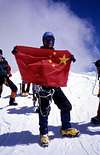|
|
Mountain/Rock |
|---|---|
|
|
43.79660°N / 88.40220°E |
|
|
Mountaineering |
|
|
17874 ft / 5448 m |
|
|
Overview
Mount Bogda (Bogda Feng in Chinese) is the highest peak in the Bodga Ola Range, an eastern sub-range of the great Tien Shan range. Although it is dwarfed by the 7000m plus high peaks (Pik Pobedy 7495 m and Khan Tengri 7010 m) in the main range of Tien Shan, its close proximity to a provincial capital makes it a popular mountain for Chinese mountaineers.Despite its moderate height, Mount Bogda is a difficult peak as most of its slopes are in excess of 70 degrees. The permanently snow-capped summit crowns an east-west trending ridge with 7 peaks over 5000 meters; a large glacier flows by its feet. The standard northeast ridge route is the only successful route ever to climb Mount Bodga. It is a basic snow/ice climb with an average gradient of about 60 degrees. At the foot of Mount Bogda, the man-made Lake Bogda (Lake Tianchi, or "Heavenly Lake" in Chinese), elevation 1980m, is a popular tourist attraction for boating, picnicking, horseback riding, and Kazakh ethnic culture.
Mount Bogda was first climbed in 1981 by a 11-person team from Kyoto, Japan.
Getting There
Mount Bogda is close to Ürümqi, a provincial capital city with frequent air service.The base camp is at the north foot of the peak, in the valleys above Lake Bogda, at elevation 3540 m. The lake is about one and a half hour drive (120 km) NE of Ürümqi. In summer tourist season transportation to Lake Bogda can be easily arranged from Ürümqi. At the lake you can arrange logistics with the Kazakh horsemen who operate horseback riding services there. To reach BC one would first cross Lake Bogda by motor boat, then trek southward for 25 or 30 km, depending on the route chosen. Supplies can be carried on horseback or by man-drawn wagons. The approach route traverses valleys with swamps and depressions.
Red Tape
Climbers are required to register with the China Xinjiang Mountaineering Association (CXMA) in Ürümqi. There is a US$30 per person fee, according to this UIAA web site (Union Internationale des Associations d'Alpinisme).CXMA address: No. 1 Renmin Road, Ürümqi, Xinjiang, China. Fax:+86-991 2818365
Lodging
Stay in Kazakh traditional felt tents ("yurts") at Lake Bodga. You can also stay in the city of Ürümqi.When to Climb
Best climbing season is from June to August.Typical weather conditions: It is arid and scorchingly hot on the foothill plains but humid and cold in the middle and upper parts of the mountain. Average temperatures in January ranges between -16 C/3 F and -19 C/-2 F, in July: 10 C/50 F to 12 C/54 F. Yearly precipitation is no more than 200 mm/8 in, and most of it falls in July and August. Between the end of September and the end of May, snow can accumulate up to about 65 centimeters (2 feet) and make the approach inconvenient. Average wind speed is 2.7 to 2.9 meters per second (9 to 10 feet per second); there are seldom strong winds around the peak area. Typically the weather turns more windy and cloudy in the afternoon.
Adopt this page!
This page's current maintainer is willing to let anyone who is more familiar with this peak to adopt the page. If interested please contact gordonye.External Links
- Xinjiang Mountaineering Association's Bogda Feng Page
Ürümqi Mountaineering Team's 1998 expedition to climb Bogda Feng (Chinese language site, with many photos).
- Bogda 2004 Expedition
We're a 12-climber expedition, the only team in 2004 to climb this mountain. Due to continnous bad wather, only 3 climbers (including 2 guides from Alaska) managed to reach C3 (5080m) after a struggle of 11 hours from C2 (4700m).














Kristian - Nov 18, 2003 7:30 pm - Hasn't voted
Untitled CommentNortheast ridge and standard route